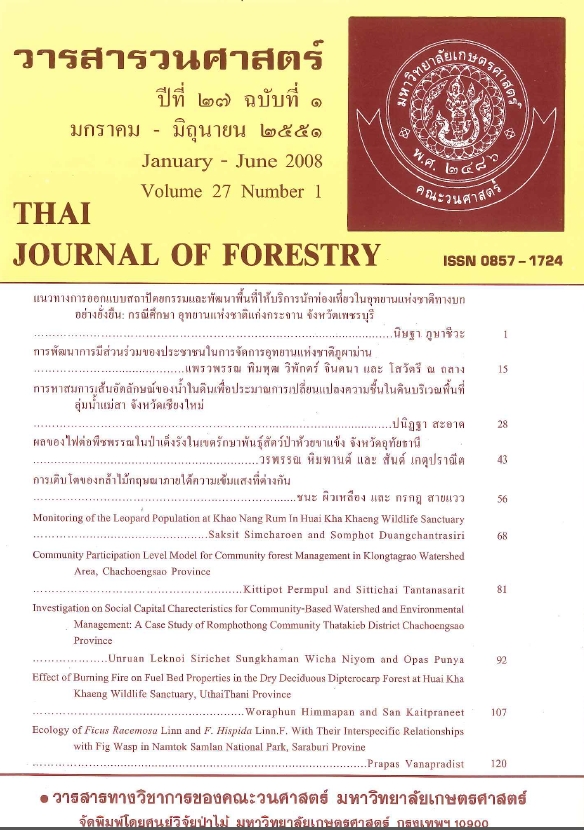การหาสมการเส้นอัตลักษณ์ของน้ำในดินเพื่อประมาณการเปลี่ยนแปลงความชื้นในดิน บริเวณพื้นที่ลุ่มน้ำแม่สา จังหวัดเชียงใหม่
Main Article Content
บทคัดย่อ
การศึกษาเพื่อหาแบบจำลองเส้นอัตลักษณ์ของน้ำในดินที่เหมาะสมกับการประเมินค่าการเปลี่ยนแปลงความชื้นในดินบริเวณพื้นที่ลุ่มน้ำแม่สา จังหวัดเชียงใหม่ ทำการเก็บตัวอย่างดินที่ 3 ระดับความลึก ได้แก่ 5, 115 และ 215 เซนติเมตร รวมทั้งสิ้นจำนวน 21 ตัวอย่าง จากพื้นที่ 7 แห่ง ที่กระจายครอบคลุมทั่วทั้งพื้นที่ลุ่มน้ำแม่สา ได้แก่ บ้านบวกจั่น บวกเตย ผานกกก แม่สาใหม่ โป่งไคร้ ห้วยดอกงิ้วและแม่แมะ โดยพิจารณาเปรียบเทียบระหว่างสมการของ Brooks and Corey สมการของ Campbell และ สมการของ Van Genuchten กับเส้นอัตลักษณ์ของน้ำในดินที่เกิดขึ้นจากการเก็บวัดในพื้นที่ศึกษา จากนั้นนำค่าสัมประสิทธิ์ของสมการที่เหมาะสมที่สุดไปใช้ในแบบจำลองประเมินค่าการเปลี่ยนแปลงความชื้นในดิน โดยทำการตรวจสอบความถูกต้องของแบบจำลองด้วยค่าประสิทธิภาพของแบบจำลองของ Nash and Sutclife (EFF) และปรับเทียบแบบจำลองด้วยวิธี Generalized Reduced Gradient
ผลการศึกษาพบว่า ความสัมพันธ์ระหว่างความชื้นในดินกับพลังงานกำกับก้อนดินระดับต่างๆ ทั้ง 21 ตัวอย่างจากห้องปฏิบัติการ มีลักษณะการเปลี่ยนแปลงความชื้นในดินไปในทิศทางเดียวกันคือ เมื่อเพิ่มแรงดันในการผลักน้ำออกจากดินมากขึ้นปริมาณน้ำในดินจะลดลง และเมื่อเปรียบเทียบความสัมพันธ์ดังกล่าวตามระดับความลึกที่แตกต่างกันทั้ง 7 สถานี พบว่า 5 สถานี มีปริมาณความชื้นในดินที่ทุกระดับพลังงานกำกับก้อนสูงกว่าดินชั้นที่ลึกลงไป ส่วนอีก 2 สถานีพบว่าดินชั้นล่างมีค่าดังกล่าวสูงกว่าดินชั้นบน เนื่องจากการใช้ประโยชน์ที่ดินที่มีผลต่อปริมาณช่องว่างในดินทำให้ความสามารถในการเก็บกักน้ำของดินบนลดน้อยลง เมื่อนำผลการศึกษาที่ได้ไปหาสมการเส้นอัตลักษณ์ของน้ำในดินที่เหมาะสมที่สุดพบว่า ค่า R2 ของทั้ง 3 สมการไม่แตกต่างกันมากนัก แต่สมการของ Van Genuchten มีลักษณะเส้นอัตลักษณ์ของน้ำในดินที่ใกล้เคียงเส้นแนวโน้มจากห้องปฏิบัติการมากที่สุด โดยเฉพาะในส่วนที่ใกล้จุดตัดแกน y ของกราฟ ซึ่งเป็นค่าความชื้นเมื่อดินอิ่มตัวด้วยน้ำที่ระดับพลังงานกำกับก้อนดินเป็นศูนย์ ดังนั้นจึงนำค่าสัมประสิทธิ์จากสมการของ Van Genuchten ไปประยุกต์ใช้ในแบบจำลองเพื่อประมาณค่าการเปลี่ยนแปลงความชื้นในดิน ซึ่งพบว่าการเปลี่ยนแปลงความชื้นในดินที่ได้ก่อนการปรับเทียบแบบจำลองมีค่าต่ำกว่าค่าที่ได้จากการตรวจวัดจริงค่อนข้างมาก อย่างไรก็ตามหลังจากการปรับเทียบแบบจำลองแล้วพบว่าแนวโน้มการเปลี่ยนแปลงความชื้นในดินจากแบบจำลองมีความใกล้เคียงค่าที่ตรวจวัดได้จริงมาก ค่าความพรุนรวมและสัมประสิทธิ์การนำน้ำเมื่อดินอิ่มตัวที่ทำให้ค่า EFF มีค่าสูงสุด (0.9397) คือ 0.4988 และ 0.0001 เซนติเมตรต่อวินาที ตามลำดับ
คำสำคัญ: ความชื้นในดิน พลังงานกำกับก้อนดิน สมการอัตลักษณ์ของน้ำในดิน การเปลี่ยนแปลงความชื้นในดิน ลุ่มแม่น้ำสา
Downloads
Article Details

อนุญาตภายใต้เงื่อนไข Creative Commons Attribution-NonCommercial-NoDerivatives 4.0 International License.
ข้าพเจ้าและผู้เขียนร่วม (ถ้ามี) ขอรับรองว่า ต้นฉบับที่เสนอมานี้ยังไม่เคยได้รับการตีพิมพ์และไม่ได้อยู่ในระหว่างกระบวนการพิจารณาตีพิมพ์ลงในวารสารหรือสิ่งตีพิมพ์อื่นใด ข้าพเจ้าและผู้เขียนร่วม (ถ้ามี) ยอมรับหลักเกณฑ์และเงื่อนไขการพิจารณาต้นฉบับ ทั้งยินยอมให้กองบรรณาธิการมีสิทธิ์พิจารณาและตรวจแก้ต้นฉบับได้ตามที่เห็นสมควร พร้อมนี้ขอมอบลิขสิทธิ์ผลงานที่ได้รับการตีพิมพ์ให้แก่วารสารวนศาสตร์ คณะวนศาสตร์ มหาวิทยาลัยเกษตรศาสตร์ กรณีมีการฟ้องร้องเรื่องการละเมิดลิขสิทธิ์เกี่ยวกับภาพ กราฟ ข้อความส่วนใดส่วนหนึ่ง หรือ ข้อคิดเห็นที่ปรากฏในผลงาน ให้เป็นความรับผิดชอบของข้าพเจ้าและผู้เขียนร่วม (ถ้ามี) แต่เพียงฝ่ายเดียว และหากข้าพเจ้าและผู้เขียนร่วม (ถ้ามี) ประสงค์ถอนบทความในระหว่างกระบวนการพิจารณาของทางวารสาร ข้าพเจ้าและผู้เขียนร่วม (ถ้ามี) ยินดีรับผิดชอบค่าใช้จ่ายทั้งหมดที่เกิดขึ้นในกระบวนการพิจารณาบทความนั้น”


